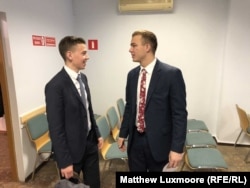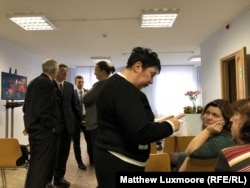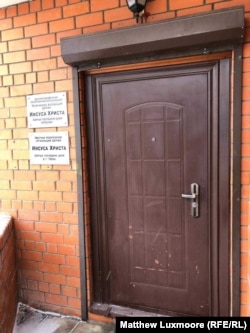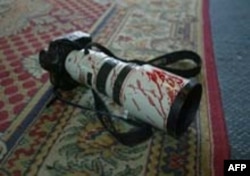TV2 in Tomsk, Siberia, was one of the last free and independent regional media outlets in Russia. But the company's unfettered journalism was not in sync with the country's increasingly restrictive political climate. The station's broadcasts were shut down at the end of 2014. The story of Tomsk TV starkly illustrates both the power of a free press and how it can be silenced.
Watchdog
Sunday 30 December 2018

TVER, Russia -- When American Ian Crookston was assigned to Russia as a Mormon missionary in 2009, the 19-year-old knew next to nothing about the country. Nevertheless, putting his undergraduate studies on hold, he set off for a year of asceticism in its gritty industrial heartland.
That meant forfeiting activities he'd taken for granted. He went offline, cut communication with friends and family, and relinquished his first name in favor of Elder, a title all male Mormon missionaries take.
From morning till late evening, between breaks for meals, scripture sessions, and Russian classes, he walked the streets of the Volga River town of Novokuybyshevsk with a fellow missionary constantly by his side. Sporting suits and smiles, the two scouted for men and boys who might be amenable to Mormonism, the religion of the Church of Jesus Christ of Latter-day Saints.
"We had a territory that we sort of wandered around, and I really do mean wandered. Just trying to harangue people on the street," he says. "It felt like everybody in the town knew who we were."
Some of the practices his cohort engaged in -- sneaking into housing blocks to proselytize door-to-door, trailing people on the street till they agreed to talk -- provoked violence from local thugs and forced church superiors to rein the pair in.
Nevertheless, by the end of his mission, Crookston had converted 27 Russians to his faith, and estimates that he'd spoken to 20,000 people. Though most of them, he says in hindsight, "wanted nothing to do with me."
'Convenient Victims'
Mormons in Russia today can only marvel at such stories.
As part of a crackdown on foreign-based religious groups, the government has imposed significant obstacles to missionary work. A package of laws passed in July 2016, and billed as an effort to combat homegrown terrorism, has confined missionary work to places of worship, clearing Russia's streets and homes of proselytizing Mormons.
A church that owes its presence in Russia to the efforts of missionaries is now effectively banned from publicly preaching the faith.
But it's not only Mormons, whose church Russia officially recognized in 1991, who have been affected by the so-called Yarovaya law, named after Irina Yarovaya, the State Duma deputy who authored it.
Some faiths have been banned outright. In April 2017, the Christian denomination Jehovah's Witnesses was branded extremist and equated in practice with supporters of the Islamic State extremist group. The Supreme Court announced the confiscation of all property in Russia belonging to the U.S.-based organization, and its estimated 170,000 members now risk jail time for congregating. According to Roman Lunkin, a religious expert at the Russian Academy of Sciences, around 100 Jehovah's Witnesses are currently under investigation on extremism charges. Many have emigrated.
In addition, over 500 charges have been brought against religious groups in connection with the Yarovaya law, Lunkin says. The majority are fines for proselytizing in public, incorrectly marked literature, and the absence of plaques designating places of worship -- most affected are the Hare Krishna movement and various Protestant denominations, which together total some 3 million members in Russia.
Some of the cases have provoked more amusement than opprobrium. In October 2017, a Russian Hindu was detained as he gave a lecture on yoga in St. Petersburg and was charged with illegal missionary work. The case was subsequently dropped, but it highlighted the precariousness of the situation. The law defines missionary work only as spreading information about one's faith to make nonmembers join, a vague formulation that critics like Lunkin believe can be misused.
Lunkin describes the religious groups targeted as "convenient victims" in a state-sponsored campaign against perceived malign foreign influence. "This is the government's reaction to the rebirth of certain stereotypes that are now being used for ideological reasons -- first and foremost, a phobia of sects and anti-Western hysteria," he says. "Ten years ago, no one paid attention to such things."
Just Making Friends
For the Mormon church, this poses a major obstacle. How do you attract new members to a faith when publicly talking about it is banned?
When the Soviet Union fell in 1991, the church seized an opportunity to establish itself in a region where atheism had been state policy for decades. Through the efforts of visiting missionaries, the Mormon presence in Russia grew rapidly: from 300 registered members in 1991 to over 14,000 a decade later. Today the Mormon church claims 23,000 adherents in Russia, but growth has since all but stalled.
After the Yarovaya law was introduced, the church leadership in Salt Lake City, Utah, issued a statement pledging to "honor, sustain, and obey" it, and announced that Mormon missionaries in Russia would alter their work in accordance with its requirements.
"For a long time the mission was closely associated with proselytizing, preaching the gospel," says Sergei Antamanov, a spokesman for the church in Russia. "But immediately after these changes took place, we realized it wouldn't be possible to operate in the same way here in Russia as the church operates in most of the world. So we had to adapt, and we had to adapt fast."
That meant downsizing the missionary force in Russia by some 100 people, Antamanov says. Missionaries were to be referred to only as "volunteers," and today focus on supporting existing members rather than expanding the flock. Gone are the black name tags linking them to the Mormon church, which together with white shirts, ties, and backpacks comprise a missionary's traditional garb.
In Tver, a provincial town 160 kilometers northwest of Moscow, Elders Schaub and Seegmiller spend their days visiting the homes of church members and roaming the streets engaging locals in small talk.
"Before, you could go up to someone and you could start a conversation about the gospel. And now, we just try and make friends," says Seegmiller, an 18-year-old who hails from Utah, the church's spiritual home. "Approaching people in a way that is natural and just developing natural relationships is hard. And it is an odd thing to do."
They're also not allowed to publicly discuss the church.
"We can answer pretty much any question, but we can't tell them ourselves," says Schaub, 20. "But most people don't ask questions." He admits there's still confusion about what is and isn't allowed.
The Tver meetinghouse is a large apartment on the ground floor of a nondescript housing block tucked away on a side street near the railway station. A metal plaque outside the front door is the only indication that the venue belongs to the Mormon church.
Inside is a bright, sparsely furnished chapel with a keyboard and a wooden pulpit. Beside the altar is a TV screen on which members watch speeches delivered by American church leaders to vast congregations at the magnificent Mormon temple in Salt Lake City. These are translated into Russian and dozens of other languages. Many are also printed in the church's Russian-language monthly, Liakhona, which is replete with glossy images of wealthy, beaming Mormon families.
On a recent Sunday, the stocky blond-haired Seegmiller stands up before the small congregation. Two months into his mission, he delivers a speech in halting Russian about the strength of his faith.
Of 10 current missionaries interviewed by RFE/RL, all speak the language. Aside from constant interaction with locals and minimal contact with home -- they're limited to weekly e-mails and phone calls only on Christmas and Mother's Day -- they chalk it up to a God-given "gift of tongues." But these days, Russian practice happens less on the streets than in meetinghouses and members' homes.
A Dangerous Sect?
With fewer than 10 members, Tver is among the smallest meetinghouses of all in the Moscow mission, one of the Mormon church's six areas of coverage in Russia. Yulia Baryayeva, a giggly kindergarten teacher in her 30s who attended the service with her two young daughters, tells RFE/RL the congregation used to be double the size. "The pensioners have died, and the young people have left," she says.
There's also a wariness among some members to advertise their ties to Mormonism. A Tver parishioner who coordinated an RFE/RL reporter's visit asked to meet three blocks away because he was worried about attracting attention to the meetinghouse. Another asked subsequently for his name to be retracted from this article, since he and his wife were afraid that knowledge of their membership in the church could cause them problems at work.
"Those who know us and those who travel abroad regularly are curious about the church," Baryayeva says. "But those who don't are suspicious, and watch all kinds of bad videos online."
Russian state media have long portrayed Mormonism as a dangerous cult, with the church's wealth and American origins held up as proof that it's used for espionage and sedition. And the Russian-language Internet is full of websites like Antimormon that list organizations claiming to "cure" former members of religious sects.
Many of them are tied to the resurgent Russian Orthodox Church, which is pressuring the authorities to stall the expansion of faiths considered alien to Russian identity.
To Georgy Belodurov, an Orthodox priest at Tver's Resurrection Cathedral, Russian Mormons are lured by the prospect of a better life in the West. "For some people America is a safe haven where paradise reigns and you live in a land of milk and honey," he says. "And the Mormon church is first and foremost the temptation of a better life."
In 2012, Belodurov published an article in the local press titled Beware, Mormons! But today he believes Russia is returning to its roots, and sees little chance that Mormons will gain traction in Tver.
"Ours is the historic, traditional church of Russia, its native faith," he says of Orthodoxy. "It matches the genetic make-up of our nation."
Keeping The Flock
In April, the Mormon leadership in Salt Lake City announced plans to build its first temple in Russia. There are now meetinghouses in over 50 Russian cities, but parishioners looking to tie the knot in Mormon tradition must travel to temples in Ukraine, Finland, or beyond. Where and when the Russian temple might arise remains unclear. Lunkin believes it's a pipe dream in the current political climate.
Matt Martinich, a U.S.-based Mormon researcher, sees the April announcement as an effort to stanch the flow of Mormons leaving Russia. The slowdown in growth has been compounded recently by high levels of emigration, he says, adding that the church's biggest challenge in Russia is keeping its members there.
That's because the Mormon church in Russia, traditionally reliant on a foreign missionary force, now depends on its existing members to expand the faith.
Antamanov, the church spokesman in Russia, is optimistic. The current obstacles, he believes, will encourage parishioners to take initiative and no longer rely on foreign missionaries to spread the word.
"It's a duty every Christian feels -- to share his beliefs with those around him," he says. "And this is an opportunity for us, for our members, to realize that's what they can do."
About This Blog
"Watchdog" is a blog with a singular mission -- to monitor the latest developments concerning human rights, civil society, and press freedom. We'll pay particular attention to reports concerning countries in RFE/RL's broadcast region.
Latest Posts
Journalists In Trouble
RFE/RL journalists take risks, face threats, and make sacrifices every day in an effort to gather the news. Our "Journalists In Trouble" page recognizes their courage and conviction, and documents the high price that many have paid simply for doing their jobs. More











